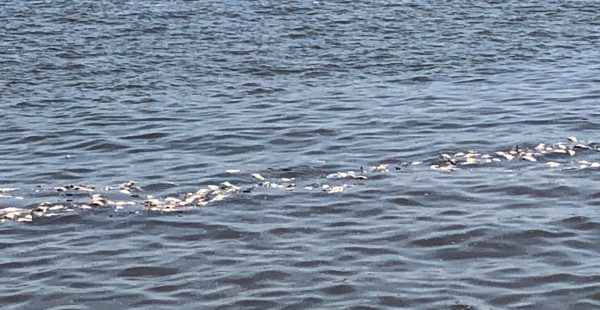Earth Matters focuses on conservation, sustainability, recycling and healthy living.
If Earth Matters to you, sign up for our mailing list and get the next installment delivered bright to your inbox.
by Sarah Scheuer
If you’ve walked along the Hudson River recently, you’ve probably seen them–or smelled them. River shores across New York and New Jersey are covered in Atlantic menhaden fish–also known as bunker–mouths agape and bodies shining in the summer sun. Some float along the water’s edge, others lie silently in the sand.
The Department of Environmental Conservation (DEC) says that the exact cause of this phenomenon has not yet been determined. Still, experts have some ideas. The main issue is that marine organisms need oxygen to breathe, and oxygen levels are low in the river. This lack of oxygen in the water is called “hypoxia.”

Dead Atlantic menhaden fish seen floating offshore at Nyack Beach State Park on July 5, 2020. Photo Credit: Dave Zornow
“Hypoxia can be triggered by large numbers of fish in confined bodies of water, excessive algal growth, and warm water temperatures,” says Jeff Wernick of the DEC.
The excessive growth of algae happens as a result of increased water temperature and/or excess nutrients, often from fertilizers and sewage facilities. The Hudson River is more nutrient rich than any other estuary on Earth.
Dr. George Jackman, aquatic ecologist at Riverkeeper, explains how excessive algal growth can lead to hypoxia in the river. “Phytoplankton [microscopic marine algae] blooms, dies, sinks to the bottom of the river, and decomposes,” Jackman says. Then, during decomposition, it sucks up oxygen. This process of algal growth that wreaks havoc on marine ecosystems is often referred to as “bloom and bust.”
(adsbygoogle = window.adsbygoogle || []).push({});
As for the warm water, global temperatures are more extreme now than ever before, especially in these hot summer months. “As the temperature goes up,” says Jackman, “it forces the oxygen out of the water.”
In the past 30 years, the Hudson’s temperature has risen by an alarming 4 degrees.
Wernick notes that “fish such as bunker that swim in large schools are particularly vulnerable to low dissolved oxygen content.” So, while the lack of oxygen is fatal for Atlantic menhaden, many other species will be able to survive this time around.
It Takes a Village to Cover Our Villages.
 Local news matters now more than ever. Nyack News & Views has covered news, arts, and culture in and near the Nyacks for a dozen years. During the COVID-19 crisis, we’ve doubled down on content, bringing readers service-oriented news you can use.
Local news matters now more than ever. Nyack News & Views has covered news, arts, and culture in and near the Nyacks for a dozen years. During the COVID-19 crisis, we’ve doubled down on content, bringing readers service-oriented news you can use.
We need your help–NOW–to continue this work. Please consider making a one time or sustaining donation to Nyack News & Views. Thank You!
The climate conditions that are causing the deaths of so many Atlantic menhaden must be taken seriously. “This is an ominous sign of what’s to come in the future with climate change,” Jackman warns. “If we do not heal this river.”
Take action to help the river here.
Calculate your carbon footprint and find ways to reduce it here.
Sarah Scheur is a Nyack News & Views intern.









